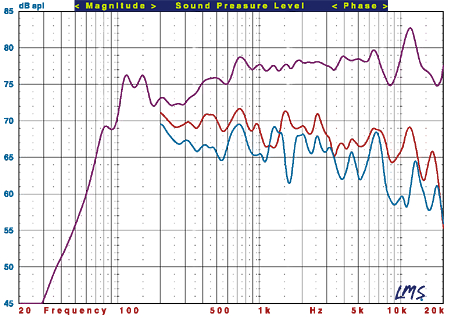Magnepan MG 3.6 1.6, CC3 surround speaker system Measurements
The MG 3.6 speakers arrived at our studio fresh from a cross-country flight but missing their external crossovers. Time was short, but fortunately there was a Magnepan dealer nearby. Many thanks to Bill Kavinski, of Shelley's Stereo in Woodland Hills, California, for loaning us a replacement crossover for our mea-surements.
The MG 3.6's sensitivity measured approximately 80dB at 2.83V/m. Its minimum impedance in the lower midrange and below was 4.1ohms at 150Hz, dropping to 3.4ohms at 10kHz; I would rate the nominal impedance at 4ohms. With respect to impedance (both magnitude and phase), the MG 3.6 should be relatively easy to drive for any amp comfortable with a 4ohms load. This benign nature is fortunate, given the 3.6's very low sensitivity. I strongly recommend a high-powered amplifier to drive the Maggies. Its 80dB/2.83V/m sensitivity will require four times the power of a speaker measuring 86dB/2.83V/m (more typical of consumer loudspeakers) to produce the same sound level.
There are a number of hazards involved in making pseudo-anechoic measurements of a flat-panel speaker. The speaker's large diaphragm makes the microphone position required by such measurements less than ideal, and its dipole nature means that the differences between its in-room and test-bench perfor-mances will be more pronounced than those of a more conventional speaker. Even measurements made in the largest true anechoic chamber will not fully characterize the way such a speaker performs in a real room. Keep that in mind when interpreting and weighing our measurements against the listening tests.
The pseudo-anechoic response of the MG 3.6, measured inline with the tweeter at mid-tweeter height and averaged over a 30° forward horizontal angle, is shown in Figs.1a and 1b (violet). Note that the side-by-side drivers make the off-axis response asymmetrical. The useful bass extends down to approximately 38Hz (–10dB relative to the output at 100Hz). The on-axis average measurement is rather uneven: elevated in the lower midrange, down in the presence region. The off-axis response is less smooth still; the dip between 1.2kHz and 2.2kHz (different on the left and right sides), combined with the impedance characteristics (not shown), suggests that the crossover frequency is somewhere in this region.

Fig.1a: Magnepan MG 3.6, pseudo-anechoic horizontal response at 45° (red) and 60° (blue) relative to tweeter axis; off-axis measurements taken on tweeter side.

Fig.1b: Magnepan MG 3.6, pseudo-anechoic horizontal response at 45° (red) and 60° (blue) relative to tweeter axis; off-axis measurements taken on woofer side.
Fig.2 again shows the MG 3.6's averaged horizontal front response (violet), plus the vertical responses taken at +15° (red) and –15° (blue) relative to the middle of the tweeter panel. Within the limits shown, the listening height appears relatively noncritical.

Fig.2: Magnepan MG 3.6, pseudo-anechoic vertical response at +15° (red) and –15° (blue) relative to tweeter midpoint.
The CC3 center-channel's minimum impedance was 4ohms at 100Hz. It drifted down to 3.6ohms at 20Hz, but because of the speaker's limited low-frequency output, I don't judge this to be significant. I would rate its nominal impedance at 5ohms. Overall, the CC3's impedance should be relatively easy to drive—again, this is fortunate, as the CC3's sensitivity measured approximately 78dB/2.83V/m, even lower than the MG 3.6's.
The CC3's measured front horizontal response, taken at the middle of the tweeter's vertical axis and averaged in the same manner as described above for the MG 3.6, is shown in Fig.3 (violet). The useful bass extension is approximately 70Hz (–10dB relative to the output at 110Hz). The CC3's on-axis response through most of the audible range is smoother than the MG 3.6's, though the response is lean below 600Hz and uneven above 7kHz. The off-axis response is relatively linear, though significantly down in level compared to the on-axis response.

Fig.3: Magnepan CC3, pseudo-anechoic horizontal response at 45° (red) and 60° (blue) relative to tweeter axis.
The +/-15° vertical off-axis performance of the CC3 (Fig.4) is relatively consistent with the on-axis response, though slightly better on or below the tweeter axis than above.—Thomas J. Norton

Fig.4: Magnepan CC3, pseudo-anechoic vertical response at +15° (red) and –15° (blue) relative to tweeter axis.
- Log in or register to post comments





























































